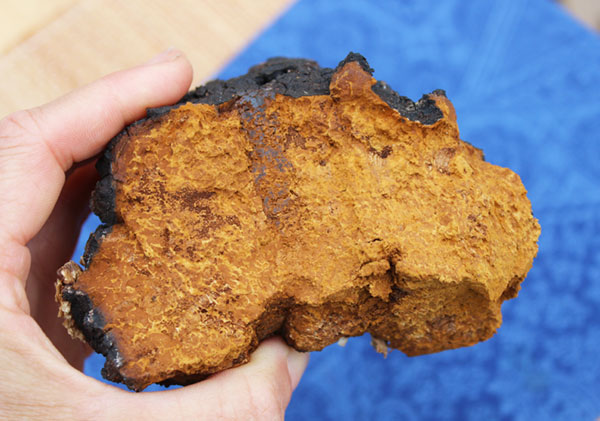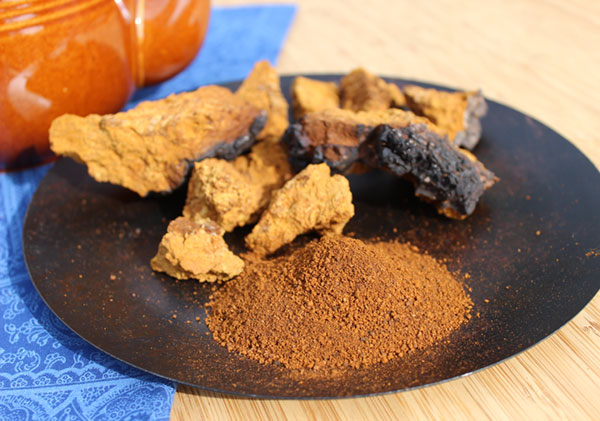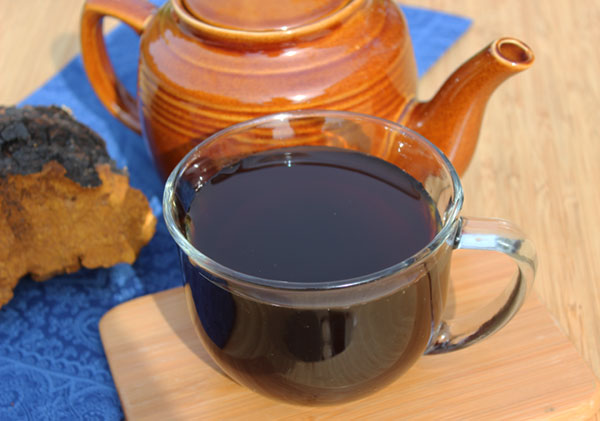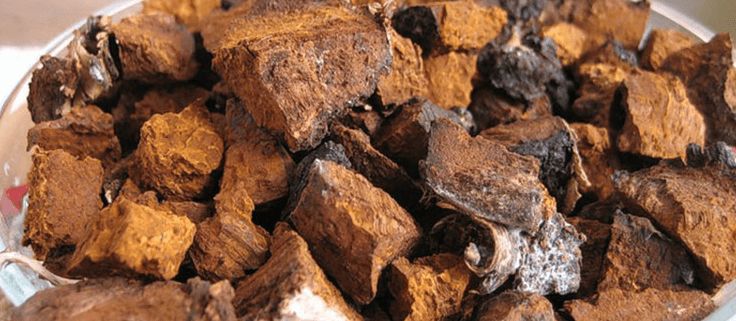Chaga Mushroom Benefits
Chaga, Inonotus obliquus, is a rather unusual looking
medicinal mushroom species that’s not your typically polypore but one
that grows as a black sclerotium or conk on the side of living trees.
The
birch tree, being its preferred tree of choice, is believed to hold the
most nutritional elements needed for the mushroom’s growth and
condensed amount of beneficial myconutrients.
Inonotus obliquus has been a widely utilized ethnobotanical species in Russia, Scandinavia and Baltic regions throughout human history.
Naturally growing wild in colder climate zones of the Northern Hemisphere, including Canada and North America, it is highly adaptable to environmental extremes which encourage the release and concentration of immune responsive compounds, antioxidants and various phytochemicals needed for its continued survival.
Consumed as a decocted tea, hot water extract or liquid solution, the mushroom is considered a nourishing “superfood” and medicine for its transferred immune-modulating and protective influence.
Dark, rich chaga tea is a delicious tasting hot morning beverage with a bitter-sweet full-bodied flavor and makes a great coffee alternative if you’re trying to reduce caffeine consumption. Or likewise, powdered extracts can be added to coffee, teas or elixirs.
Here on this page, we will discuss chaga-specific nutrients and how
this profound species can serve as a preventative healthcare approach to
support long-term immune system functioning and well-being.

Health Benefits of Chaga Mushroom
Properties as a Biological Response Modifier and Adaptogen
The Inonotus obliquus mycelium, growing as a hard cork-like
mass, works in relationship with the immune defenses and lignins of its
host tree. Over a period of time, it builds up potent compounds that are
edible to humans and likewise identified to encourage healthy immune
functions.
One of the constituents created are the class of polysaccharides called beta-glucans. Also found in other medicinal mushrooms, like reishi, coriolus and maitake, these are highly structured molecules with a developed length and frequency of branching side-chains.
They are often called “biological response modifiers” (BRMs) because of their potential ability to “modify” or “modulate” biological immunity either by increasing or suppressing immune response, depending on what is most needed by the organism. (*)
Chaga mushroom needs to be heated via hot water or alcohol to release its beta-glucan content. It can be consumed as a daily tea or extract to help restore and maintain optimal immune system responses.
Frequently called the “king of mushrooms”, Inonotus obliquus
is a hardy fungal species adaptable to growing in extremely cold
climates commonly reaching -40 °F (-40 °C). These conditions help to
produce certain constituents like triterpenoid saponins, similar to
those present in tonic herbs like gynostemma, ginseng and astragalus.
Regular
use of adaptogens, like chaga, are proposed to improve the body’s
ability to build resistance to stress, trauma, anxiety and fatigue as
well as environmental pollutants we are all invariably exposed to in our
daily lives.
In this sometimes overwhelming fast-paced modern world, we feel that dietary adaptogens can be extremely important therapeutic superfood allies for maintaining long-term health over the course of a lifetime.
The best types of chaga to consume for
highest benefits are WILD varieties that have matured to at least 5
years or older. This is because the adaptogenic compounds slowly build
up potency and are developed through seasonal exposure to extremely cold
temperatures.

Antioxidants and Other Immune Supporting Myconutrients
Antioxidants
are molecular substances that can be naturally created by the body or
acquired through dietary sources. They are known to be one of the key
factors that control how fast humans age. Internal production of these
micronutrients can decline significantly as we grow older, so it becomes
especially important to increase consumption through the foods we eat
as we move along in chronological years.
Antioxidant-rich food
sources are valued for their ability to shield the body against the
damaging effect of “free radicals” and protect against damage to
cellular tissue and DNA structure.
Chaga is known to have one of the highest amounts of enzymatic and non-enzymatic antioxidants of any plant-based food or herb (*), a substantially dense array of which are concentrated into its black and rusty colored pigmentation.
Inonotus obliquus antioxidants include:
- betulin
- betulinic acid
- lupeol
- inotodiol
- lanosterol
- ergosterol
- lanostane
- melanin
- superoxide dismutase (SOD)
- beta-glucans
- tripenoid saponins
- zinc
Contains Betulinic Acid, Lupeol and Other Antimicrobials
One of the main active components unique to Inonotus obliquus
is its high concentration of betulinic acid. This, along with lupeol,
is a metabolite of betulin, a white powder-like material common to many
birch species that holds powerful antimicrobial attributes.
Chaga
extracts these triterpenes out of the tree bark, condensing a
significant portion into its black sclerotium and into a form digestible
by humans when prepared as a tea or tincture.
Both betulinic acid and lupeol have been shown to possess a wide spectrum of biological and medicinal activities that have been studied for their antiviral, antitumor and anti-inflammatory qualities. (*)
We like to buy whole one-pound chaga chunks for herbal preparations because they also come with a good portion of this potent burnt-like outer layer. Most quality suppliers, however, will always use mushrooms with a certain percentage of this exterior crust for highest beneficial nutriments, like betulinic acid.
Inotodiol, Lanosterol, Ergosterol and Lanostane
Two
other antimicrobial compounds found in chaga include inotodiol,
lanosterol as well as lanosterol’s metabolites, ergosterol and
lanostane. The term
antimicrobial makes reference to four main subcategories: antiviral,
antifungal, antiparasitical and antibacterial.
These chaga-derived sterols can provide immune-supporting actions and, like other mentioned antioxidants, may help to combat oxidative damage to cellular DNA structure. (*)
From our personal experience, we have found the consumption of chaga tea to be a profound
therapeutic ally for combating potential latent viral infections that
can, over time, disrupt our innate immune responses and increase the risk of
certain autoimmune diseases.
Regular consumption of the mushroom extracts or teas may also be able to greatly assist in eliminating the overgrowth of fungal yeast strains, like candida, in the GI tract. Because the intestinal tract works with the immune system via the “gut-associated lymphoid tissue” to make immune cells, maintaining a healthy diverse community of yeast and bacteria in the colon plays a major role in human immune function.
Chaga’s
anti-inflammatory properties have also been traditionally used as a
medicinal folk remedy for gastrointestinal disorders like ulcers,
colitis and gastritis.
Rich Source of Melanin, Can Help to Protect the Skin
Also found in the crusted charcoal-like layer is the natural pigment
called melanin. The word melanin in Greek means “black or dark” and is
the pigmentation that gives the eyes (pupil), skin and hair their color.
Also found in the nervous system, adrenals and pineal gland, it is a
nutrient produced by the body, but can become depleted with stress,
genetic triggers and age.
Chaga is one of the highest sources
of dietary melanin in the plant world and can be taken to nourish
nutritional deficiencies. It is found to be a potent antioxidant with
potential DNA repairing actions and genoprotective effects. (*)
One
of the top claimed health supporting properties of melanin uptake is
that it helps to shield the skin from UV sun damage and radiation
exposure. It is believed to do this by dissipating a large percentage of
radiation as heat via a process known as “internal conversion”, an
essential quality for providing photoprotection.
For this reason, many leading health experts consider internal consumption of chaga tea and preparations to be useful as a natural sunblock and radioprotective supplement.

How to Use
Chaga Tea
While it is an edible mushroom, it is not typically ingested like culinary mushrooms due to its tough cork-like texture.
Most
people, however, enjoy the rich taste of chaga tea as it has a
pleasantly sweet, earthy and slightly vanilla-like flavor due to its
vanillic acid content.
Although raw powder or tea bags can be simply infused into hot water, for highest health-enhancing effects it is best to simmer it in water for a period of time.
When using
powder, decoction brew time is reduced compared to large pieces. When
using powder, because there is more surface area, only 20-30 minutes
simmering time is needed.
Larger conk chunks can be brewed on low heat for 1-8 hours, depending on the size. Lowholenger simmering times are believed to produce a stronger decoction and release more beneficial myconutrients, like triterpenes and beta-glucan polysaccharides. Decocted chunk pieces can be reused to make more tea as they still contain these valuable components.
When infusing straight ground powder into hot water, remember that it doesn’t dissolve and will need to be strained out.

 no
no no
no no
no